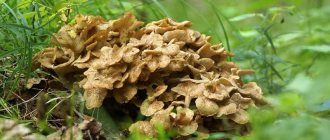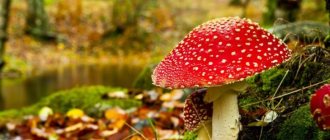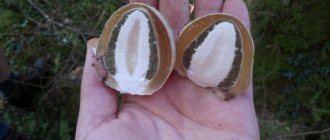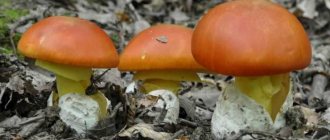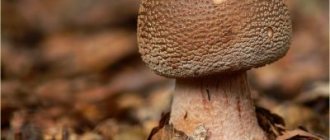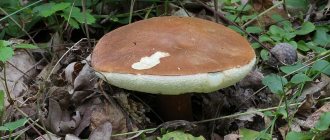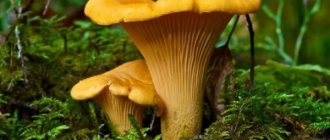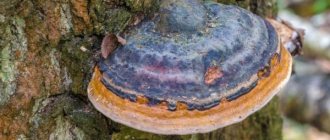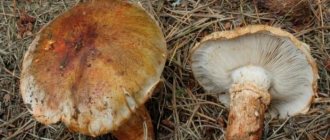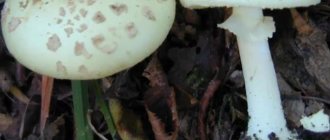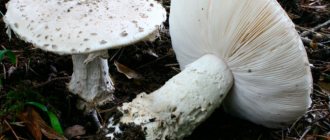Fly agarics belong to the family Fly agaric (Amanitaceae). These are one of the most mysterious mushrooms growing in our forests. There are fly agarics that are beautiful, but poisonous. Others have a less attractive appearance, but are edible. Among the fly agarics, there is even one that is considered a tasty edible mushroom of the first category.
Fly agaric red
How not to make mistakes when picking these mushrooms? There are many types of fly agaric, among them are poisonous, inedible and edible mushrooms. We will describe only a few of those that are often found in our forests. Although the list of edible fly agarics is substantial. Let's start with poisonous fly agarics, and gradually move on to edible ones.
Red fly agaric, poisonous
The red fly agaric (Amanita muscaria) grows in various forests; it grows especially beautiful under birch trees. It belongs to the poisonous mushrooms that cause suffocation, fainting, severe stomach upsets, and occasionally fatal cases of poisoning have been reported. R.B. Akhmedov, whose opinion can be trusted, writes:
The mushroom is poisonous, but deaths from poisoning are rare. An absolutely lethal dose of poison is contained in 3 - 5 fly agaric mushrooms.
R.B. Akhmedov successfully uses “fly agaric” tinctures, ointments, extracts, etc. in the treatment of a variety of diseases, including cancer.
Hat. The elegant mushroom has a red, orange-red cap (up to 20 cm in diameter) with dazzling white or yellowish spots-warts. In young mushrooms, its shape is spherical (“red egg”). With age, the cap straightens and becomes flat. On the underside of the red fly agaric cap, frequent white or cream plates are visible. The pulp is white, yellowish-pink under the skin, with a faint mushroom odor.
The leg (up to 25 cm high) is strong, white, decorated with a white or yellowish hanging ring. Rows of white or yellowish warts are clearly visible on it. At the bottom of the stem there is a thickening - a tuber with flakes. The mushroom grows in a wide variety of forests and appears en masse from July to October.
Usage. Red fly agaric is used in everyday life to kill flies. Its cap is placed on a plate, filled with hot water and sprinkled with granulated sugar. The result is a poisonous syrup, flies flock to it to feast on it and... die.
Fly agaric red
Medicinal properties
Mushrooms are widely used in folk medicine. They are used in the treatment of the following diseases:
- arthritis;
- gout;
- eczema;
- gastrointestinal diseases;
- sclerosis;
- eye diseases;
- joint diseases;
- insomnia.
Interesting!
Some traditional healers believe that mushrooms have medicinal properties that help fight tumors, diabetes and paralysis.
Mushrooms have a wound-healing effect. Many mushroom pickers apply the crushed cap to the damaged areas. Fly agarics are used as a pain reliever for rheumatism. Many cosmetic companies use some of the components included in mushrooms to create anti-aging products.
Use of fly agaric in medicine
Fly agarics contain the following active substances:
- muscarinic poisons;
- cholines;
- bufotenine;
- ibotenic acid;
- putrescine.
Active components of fly agaric
Some of the above substances in a certain dosage can pose a danger to human health and life.
Fly agaric, bright yellow, poisonous
The bright yellow fly agaric (Amanita gemmata) is considered deadly poisonous in most countries. It grows from early summer to autumn.
The cap has a bright yellow, lemon or orange-yellow color. There are many white “flakes” on its surface, which are the remains of the bedspread. At a young age, the cap plates are white; later they can turn brownish. The aroma of the pulp is reminiscent of radish.
Leg. The leg is fragile, not always velvety, and is often elongated. Its ring may disappear completely as the fungus matures. The base of the leg is widened. This is what you need to pay attention to so as not to confuse the poisonous fly agaric with russula.
Bright yellow fly agaric, photo from Wikipedia
Description of appearance
Although this family has a large number of species, most of the external features are almost the same. The main features are:
- The cap is dome-shaped, which, when the mushroom grows, opens and transforms into the shape of an umbrella. Very old specimens are distinguished by a flat or saucer-shaped cap. The sizes are always different, even for mature mushrooms, ranging from six centimeters to 22 centimeters in diameter. The color varies, but the most common are caps of red shades with decoration on the surface in the form of large white scales. The color depends on the species, as well as the place of growth. Fly agarics of the same species can have caps of different shades of the same color
- The leg is lumpy, scaly and almost always has a white color or shades thereof. Height ranges from six to almost thirty centimeters. Fleshy, dense structure. The shape is cylindrical, but slightly widens towards the base. Also, the leg is always decorated with a white skirt characteristic of fly agarics, which remains from its shell
- The flesh of the leg is white or cream. The aroma (mushroom) is not strong
- On the inner surface of the cap there are plates, the width of which does not exceed one and a half centimeters
The beads (spores) on the mushroom cap are the spreading element of the mushroom.
An important feature of the appearance is that it is very beautiful. That is why all primers and children's books contain its description and information that it is poisonous and not edible. Just to scare away small children, from ancient times in Rus' they began to associate him with Baba Yaga and other negative fairy-tale characters.
Panther (leopard) fly agaric, poisonous
Leopard mushroom (Amanita pantherina), sometimes called “leopard mushroom,” is a poisonous mushroom. Poisoning by them is serious, although deaths are rare. This mushroom should not be confused with the edible gray-pink fly agaric. The pleasant smell of the pulp can be misleading. Its color does not change when broken.
The panther fly agaric, a very poisonous mushroom, grows in coniferous and deciduous forests. It bears fruit from July to October.
The cap (up to 9 cm in diameter, rarely larger) is gray-brown, ocher-brown and even black-brown. There are many small white warts on its surface, resembling small drops of milk. The plates are white. The flesh of young fly agarics is white, with the smell of radish.
The leg is thin, hollow, cylindrical (up to 13 cm long), at the end there is a tuberous thickening with two to three belts. A membranous ring is noticeable (sometimes very faintly) on the stem.
Panther fly agaric, photo from Wikipedia
Application of mushrooms
As it turns out, the correct use of poisonous mushrooms can save a person from many ailments. They are used both externally and internally.
With a strictly calculated dosage, fly agaric is recommended for problems such as:
- skin diseases - diathesis, eczema, neurodermatitis;
- muscle and joint pain;
- headache;
- radiculitis and rheumatism;
- male impotence;
- eye diseases;
- diabetes;
- tuberculosis;
- epileptic seizures;
- oncological lesions.
And this is not a complete list of all the diseases for which this mushroom can help.
The common red fly agaric, which is the most common, can be used in the form of an alcohol tincture, juice, dried raw material, or ointment. All these remedies are used externally for varicose veins, for healing long-lasting wounds, for burns, bruises, and joint inflammation.
The tincture can be prepared with alcohol or vodka. The crushed caps should be kept in the refrigerator for three days, after which they are filled into a jar and poured 1 cm above the mushrooms. Leave the mixture for 15 days in a dark place and filter.
The ointment can be prepared from fresh mushrooms, grinding them into a paste and mixing with sour cream. Or first prepare the powder by drying the fly agaric caps, then grind them and add Vaseline or vegetable oil to them.
Today, special medicines based on poisonous mushrooms have already been released - fly agaric ointment, tincture, medicinal creams, homeopathic preparations.
Amanita toadstool (lemon, white fly agaric), inedible
The fly agaric (Amanita citrine) does not look as attractive as the red fly agaric. This mushroom is smaller. Amanita muscaria has long been considered unambiguously poisonous. However, recently, mycologists in some countries have removed it from the list of poisonous, transferring it to the “stan” of inedible (due to the bitterness, unpleasant smell and taste of raw potatoes).
The cap (up to 10 cm in diameter) with age becomes not whitish, but yellowish-greenish and even brownish with large dirty white growths. In adult mushrooms they look like hanging flaps. The plates are white or cream-colored, with a flaky coating along the edges. The pulp is white or lemon-colored.
The leg (up to 12 cm high) is thin, with flakes, and has a yellowish-beige hanging ring. At the base it expands and forms a tuberous thickening.
The white fly agaric appears towards the end of summer and grows from August to October. It has a variety - the inedible lemon white fly agaric (Amanita citrine alba). The peculiarity of this fly agaric is its pure white color. These fly agarics look nice: neat, clean mushrooms with a tuber at the base of the stem.
Amanita toadstool, photo from Wikipedia
Medicine prescriptions
Preparing medicine is not difficult, the main thing is to do it correctly. The most common medications are ointment and tincture for external use. Cooking methods:
- To prepare the ointment, only the caps are used. They are ground into powder and weighed. Add fatty sour cream to the powder in an amount equal to the mass of the caps. The finished ointment is stored in the refrigerator in sealed glass or ceramic containers.
- Tincture for external use is used for compresses and rubbing. Only caps are also used for cooking. They are crushed and placed in glass or ceramic containers. Hats should be kept in the cold for 3 days.
Mushroom tincture
Then the container intended for infusion is filled ¾ with crushed caps, and the rest of the space is filled with vodka. Mushrooms are infused in a dark place for 2 weeks. Alcohol tincture should absolutely not be taken orally. Alcohol multiplies toxicity several times.
You may be interested in:
What the boletus mushroom looks like and its description (24 photos) The bright dense cap, reminiscent in color of autumn foliage, the thick stem, impressive size and pleasant taste made...Read more...
Due to the high risk of poisoning, utensils and instruments used during the preparation of medicines should be thoroughly washed. The products are stored out of the reach of children and pets. You can take medications only on the recommendation of a homeopathic doctor.
Amanita orange, edible
Orange fly agaric (Amanita fulva) is eaten in some regions (only after preliminary boiling), in others it is not collected, considering it a poisonous mushroom. It is dangerous to confuse it with the bright yellow fly agaric.
The cap of young mushrooms is ovoid in shape. Later it straightens and becomes flat (up to 10 cm in diameter). The darker tubercle in the central part remains for the entire life of the mushroom. The color of the cap varies from gray to orange. Its skin is smooth. There are grooves or rags along the edges of the cap. The white plates do not grow to the stem.
The leg is fragile and elongated (up to 15 cm). Most often pure white, although brown spots and flakes may be present. In the lower part it is expanded (to a greater or lesser extent).
The orange fly agaric grows from late summer to autumn. Some mycologists classify the orange fly agaric as a separate genus Float (yellow-brown float).
Orange fly agaric, photo from Wikipedia
Where does it grow?
Fly agarics are not whimsical and are located in forests of all types. The color of the mushroom cap depends on the trees growing nearby.
Fly agarics are found on all continents; they are distributed throughout the world. Almost any forest soil is suitable for mushroom growth. Most likely, each of us who has visited our nearest forest has encountered a fly agaric on our way.
Fly agaric gray-pink (blushing), very tasty
Gray-pink fly agaric (Amanita rubescens) looks unappetizing, although it is a very tasty edible mushroom. It is fried and marinated. I know people who consider the gray-pink fly agaric to be one of their favorite mushrooms. Such brave lucky ones have few competitors among mushroom pickers. They regret that many people kick or stick these common fly agarics, considering them a poisonous toadstool. Amanita muscaria is loved by flies and worms, so it is often wormy.
The cap (up to 10 cm in diameter, less often up to 18 cm) of the gray-pink fly agaric is hemispherical when young. A mature mushroom has a hump-shaped, convex cap of dirty pink or grayish pink color. It has a lot of dirty gray or brownish warty growths that resemble flakes. The plates are frequent, wide, and white. With age they become slightly pinkish.
The pulp is fleshy, thick, white or slightly pink. When broken, it slowly turns pink or acquires a wine color. Hence the second name of the fly agaric - “blushing fly agaric”. The taste is slightly sweet. There is no particular smell.
The leg (up to 15 cm high) is light, it has a soft flowing ring. Over time, the leg turns pink or dark wine. The base is thickened, but does not always have a tuberous shape.
The gray-pink fly agaric often grows in open grassy areas. Its fruiting time: June - October.
This mushroom can be cooked only after preliminary boiling, and the first water must be drained. When collecting, it is important not to confuse the gray-pink fly agaric with the panther fly agaric.
Gray-pink fly agaric, photo from Wikipedia
There are other edible fly agarics, but they should be left for those mushroom pickers who know these mushrooms by sight. Among them are the edible fly agaric (Amanita solitaria), which is similar to the deadly poisonous fly agaric (Amanita proxima) and the white stinking fly agaric (Amanita virosa). The edible fly agaric (Amanita spissa) is easily confused with the panther fly agaric (Amanita pantherina).
Video gallery
Video reviews
A selection of videos with descriptions and recipes for preparing mushrooms
Mushroom experts of the Russian Federation TV, MAYGLI. Mushrooms and Mushroom Pickers, Mushrooms BAK – Mushrooms of the LHC
